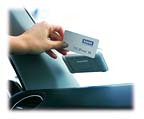Long-Range at the Perimeter

Perimeter security challenges
Kodak had a growing need to identify vehicles at long distances to secure its perimeter and control access to parking facilities and loading dock areas within its Rochester, N.Y. corporate campus. Deployment of the AVI system was the latest step in an on-going implementation of state-of-the-art security measures at the company. An additional requirement to this phase of the project was compatibility with the company’s new employee access control cards from HID Corp. of Irvine, Calif.
‘You specify it, we do the rest’
Thomas Rohr, Kodak’s manager of protective services for worldwide corporate security, had heard of the Combi Booster, a system from the Dutch company Nedap N.V. Groenlo, that incorporated HID’s prox card compatible, in-vehicle readers and transmitter devices. Since part of the Kodak systems upgrade had included the deployment of HID Duo-Prox cards for all company employees, the ability to now use the card in the Nedap device to identify employee drivers at distances up to 33 feet at high speeds, over 100 miles per hour, while also receiving a vehicle ID, was very compelling.In subsequent design discussions, a plan to use a selection of inter-compatible AVI tags was formulated. The two tags to be deployed would be the HID dual-ID Combi Booster and the single-ID Window Button. Each of these devices would serve a specific requirement.
The Combi Booster would be used anywhere that would require a vehicle to pass through a secure perimeter. In this case, it was decided that the unit’s ability to identify both the driver by his or her company-issued HID Prox Card, and the vehicle by the embedded vehicle ID in the Combi Booster itself, was of paramount importance.
In areas such as Kodak parking facilities, it was determined that the convenience of a long-distance read afforded by all the AVI tags was beneficial from a throughput perspective while still providing electronic controlled access. As a result, the Nedap single-ID Window Button was chosen. As all tags would be compatible with the same reader, the back-end system could be programmed to grant access to either type.
After extensive experimentation with various kinds of AVI equipment, Kodak determined that it would rollout the system in all areas requiring automated vehicle ID. One important factor in this decision was the system’s ability to integrate new employee ID badges with the reader transmitter device. The fact that several different compatible AVI tags were available to address different requirements within the operation also became an important part in ensuring the system would offer enough flexibility for future interoperability, implementation and expansion.

Extending the system
With such a long-range vehicle detection system in place, Kodak continues to enhance traditional access control methods with new electronic technology.In particular, the VI system’s ability to integrate with its Matrix (Dayton, Ohio) Frontier Integrated Security System has allowed data and access privileges to be controlled from Kodak’s central security system. The AVI dual-ID system was integrated into the security back-end system by assigning a two-badge rule to every Combi Booster access event.
Rohr and Kodak are actively pursuing additional applications of this product as a global solution. “The new AVI system allows vehicles to activate gates and doors far enough in advance to eliminate the need to stop. This reduces a critical and potential security choke point at the company’s vehicle entrances,” said Rohr. “Safety is being improved by eliminating the need for drivers to reach out a vehicle window for a stationary reader, typically associated with card-only vehicle access.”
Looking for a reprint of this article?
From high-res PDFs to custom plaques, order your copy today!





